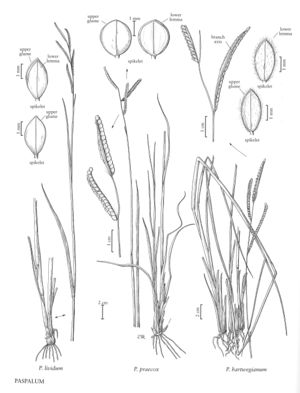Paspalum hartwegianum
Plants perennial; decumbent or cespitose. Culms 50-120 cm, erect; nodes glabrous. Sheaths glabrous, sparsely pubescent apically; ligules 2-5 mm; blades to 21 cm long, 2-5 mm wide, flat, glabrous, pubescent behind the ligules, margins ciliate basally. Panicles terminal, with 4-9 racemosely arranged branches; branches 2-6.5 cm, divergent to erect, terminating in a spikelet; branch axes 1.2-1.5 mm wide, winged, glabrous, margins scabrous. Spikelets 2.8-3 mm long, 1.5-1.6 mm wide, paired, imbricate, appressed to divergent from the branch axes, elliptic, stramineous. Lower glumes absent; upper glumes and lower lemmas abundantly pubescent, hairs longer than 0.1 mm, 3-veined, margins entire; lower lemmas lacking ribs over the veins; upper florets 2.5-2.7 mm, white to stramineous. 2n = 60.
Discussion
Paspalum hartwegianum grows in wet prairies, ditches, and swales from southern Texas through Mexico and Central America to Paraguay and Argentina.
Selected References
None.
